3099
Views & Citations2099
Likes & Shares
The management of the bio-medical waste is an emerging issue that is magnified by a lack of training, awareness, and financial resources to support solutions. The collection and disposal of this waste is of great importance as it can directly impact the health risks to both public and environmental health [5].
Public concern has been aroused about the generation, segregation, collection, storage, treatment, transportation, and disposal of bio-medical wastes, which include infectious and toxic materials. In recent years, various disposal and treatment methods intended to decrease the negative impact of medical wastes have been developed. For example, availability of information about the characteristics of medical waste is necessary to assist in the search for suitable disposal methods [6].
The population of South Sudan is on the increase and the amount of hospital waste generated is snowballing at alarming rates due to growth of population and healthcare facilities. However, there are some problems encountered with the management of bio-medical waste from waste generation to waste disposal as well as low level of awareness about the management of bio-medical waste. It is worthy to note that, Al-Sabbah Children hospital is the only national referral hospital for children in South Sudan. Given the large number of children seeking for medical care in the hospital, it is anticipated that huge amount of bio-medical waste would be generated. Therefore, this present study assesses the bio-medical waste management practices in Al-Sabbah Children Hospital in Juba-South Sudan.
Aim/Broad Objective
This study assesses the bio-medical waste management practices in Al-Sabbah Children Hospital in Juba-South Sudan.
Specific Objectives
- To determine the types of bio-medical waste generated at Al-Sabbah Children Hospital.
- To establish bio-medical waste disposal methods at Al-Sabbah Children Hospital.
Research Questions
- What are the types of bio-medical waste generated at your hospital?
- What methods are used for disposing your bio-medical waste in the hospital?
METHODOLOGY
This chapter presented the study design, study area, study population, sampling technique, data collection tool, exclusion and inclusion criteria and variables.
Study design
This research was a descriptive cross-sectional study designs which used quantitative research method. The study was conducted from June-August 2021.
Study area
Juba County is in Juba City, Central Equatoria State and South Sudan. It comprises of 16 payams namely Bungu, Dolo, Ganji, Gondokoro, Juba Town, Kator, Lirya, Lokiliri, Lobonok, Mangala, Munuki, Nothern Bari, Rejaf, Rokon, Tijor and Wonduruba payam.
Al-Sabbah children Hospital is located at Juba Town Payam. It borders Kator payam to the South, Munuki Payam to the West, Lirya Payam to the East and Gondokoro and Northern Bari Payams to the North. It is located at coordinates of 4°50'42.2"N 31°36'24.7"E. It lies at an altitude of 457 m (1499') above sea level.
The area has a tropical wet and dry climate and as it lies near the equator, temperatures are hot year-round. However, little rain falls from November to March, which is also the time of the year with the hottest maximum temperatures, reaching 38°C (100°F) in February. From April to October, more than 100 millimeters of rain falls per month. The annual total precipitation is nearly 1,000 mm (Figure 1).
Study population
The study population comprised of all staffs of Al-Sabbah children hospital. The Hospital consists of 200 Technical and Non-Technical/Support staffs as seen below (Table 1).
Target respondents
The target respondents include all the technical and some non-technical/support staffs of Al-Sabbah Children Hospital.
Inclusion Criteria
All technical staffs and some support staffs who were involved in the day-to-day management of biomedical waste were included for the study. The technical and support staffs that were included in the study were: - Pediatricians, Medical Officers, Pharmacist, Assistant Pharmacist, Registered Nurses, Certified Nurses, Clinical Officers, Theatre Attendance, Laboratory Technologist, Laboratory Technician, Public Health Officers, Human Resource, Vaccinators, Statisticians, Cleaners and Nutritionist. The Human Resource Officers as support staffs in the hospital were included for the study because they would be responsible in enforcing laws in the hospital.
Those who gave their consent for the interview were involved in the study.
The staff who worked in the hospital for more than 6 months was included in the study.
Exclusion Criteria
Guards, Drivers and Electricians were excluded in the study because they were not involved in the biomedical waste management process given the nature of their work.
Those who did not give their consent for interview were excluded from the study.
Staffs working in the hospital for less than 6 months were included in the study.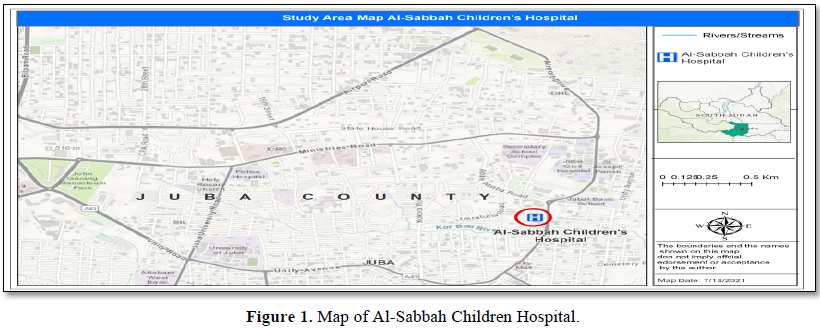
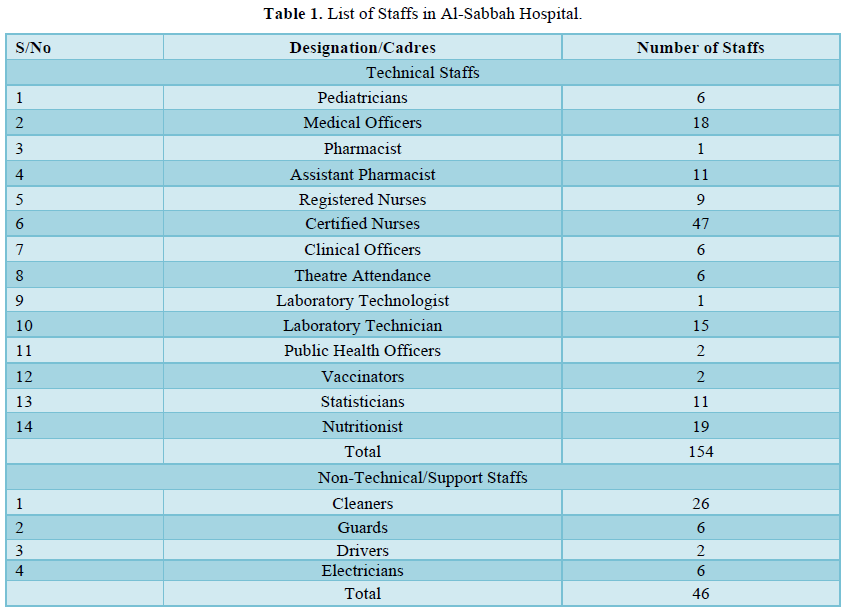
Sample size determination
Al-Sabbah Children Hospital consisted of 200 staffs both technical and support staffs. A sample size of 186 respondents was selected for the interview. These were drawn from the cadres that were involved in the day-to-day management of biomedical waste.
Sampling methods
Al-Sabbah children hospital was purposively selected for the study. This was because it is the only referral hospital for children in South Sudan and the fact that no research on biomedical waste management has been conducted in the hospital.
The hospital staffs were clustered into technical and non-technical/support staffs. They were then further clustered according to their cadres. All staffs in the selected cadres were interviewed.
Data collection tools
A Self-administered close ended questionnaire was used to collect the data. Respondents that were not able to fill the questionnaire were assisted by the research assistants to complete the questionnaire (Table 2).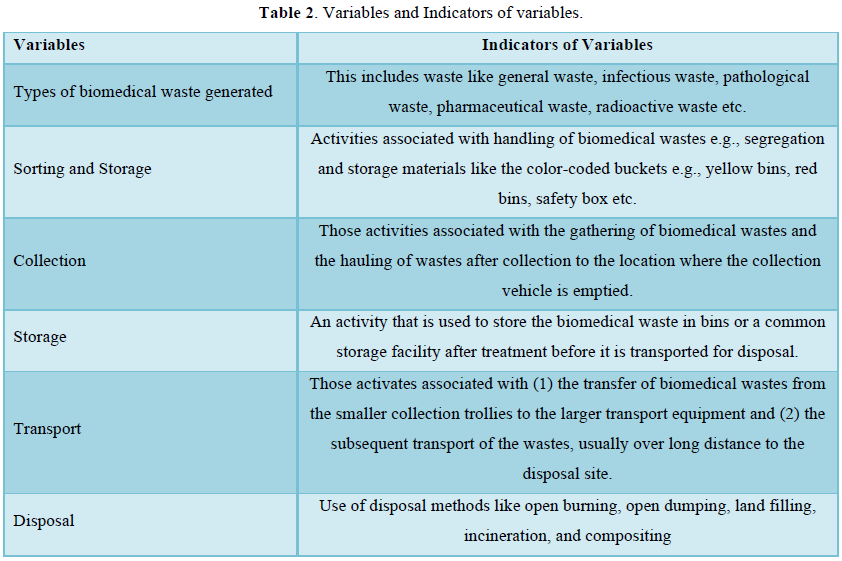
Validity and Reliability
Research assistants were trained prior to data collection and the questionnaires were pretested before the actual data collection exercise commenced. This helped the researcher to adjust and modify the questioners before the actual data collection exercise began.
Ethical considerations
An introductory letter from the school of Public Health, International Telematic University was obtained.
Clearance for conducting this research was sought from the ethical committee of research in the National Ministry of Health-South Sudan (Ref #: RERB No: 31/06/2021-MOH/REBR/A/32/2021).
Approval from the Central Equatoria State Ministry of health was obtained.
Finally, approval from Al-Sabbah Children Hospital Administration was obtained.
Written Consent was attained from the respondents prior to interviews. Any information obtained was handled with high degree of confidentiality as there was no mentioning of people’s names but using their signatures/fingerprint on the data collection tools. Any respondent who chose to decline before or during the process of the interview was free to do so.
Data processing and analysis
Responses from the questionnaires were manually validated and entered in excel spread sheet version 2019. It was analyzed and presented inform of tables and graphs.
Study limitation
The study was conducted in Al-Sabbah Children Hospital alone. This did not represent a true picture of the entire healthcare facilities in South Sudan as the structure of the health system in South Sudan starts with Primary Health Care unit (PHCU), Primary Health Care Center (PHCC), County Hospital, State Hospital and National referral/teaching hospital.
Most of the staffs in Al-Sabbah children hospital were interviewed. Therefore, to get 10% of the sample size to cater for non-respondent was difficult.
FINDINGS
Demographic Data (Table 3)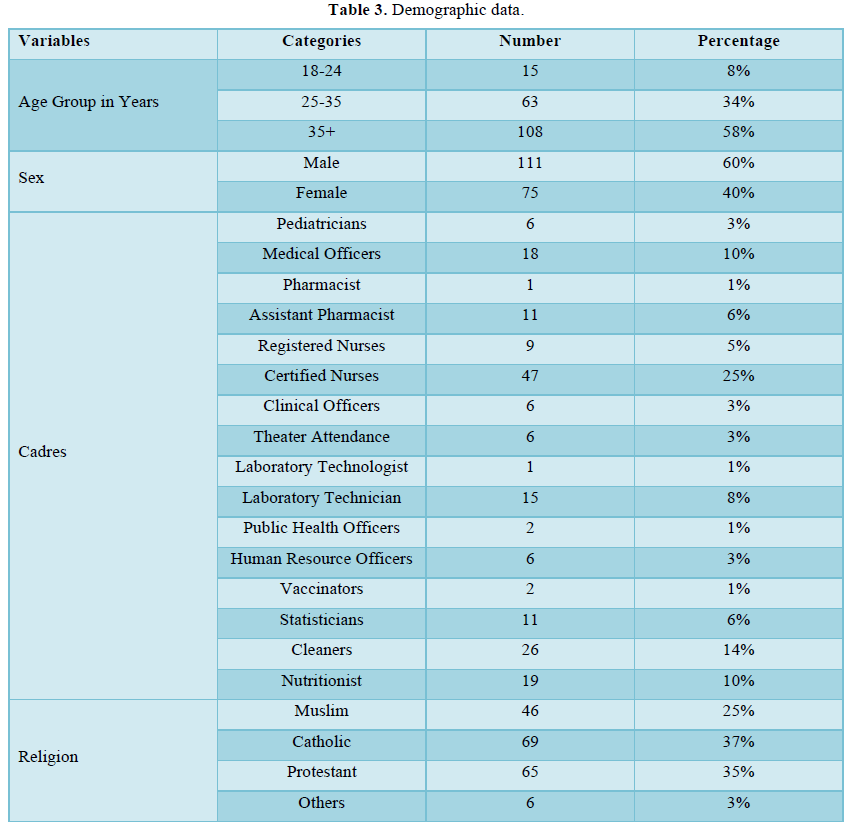
More than half of the respondent 108 (58%) were among the age group of 35 years and above, followed by 25-35 years 63 (34%) while 15 (8%) were at the age group of 18-24 years. Majority of the respondent 111 (60%) were male while 75(40%) were female. Most of the respondent 47 (25%) were certified nurses followed by cleaners 26 (14%) while the least respondent were vaccinators, laboratory technologist, Public Health officers and pharmacist representing 1% respectively.
Types of Biomedical Waste (Figure 2)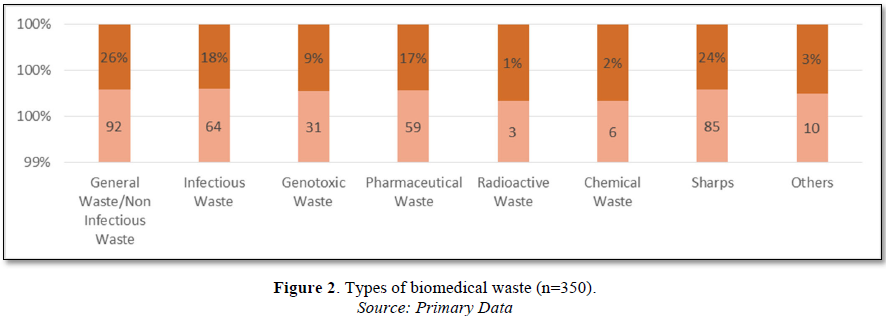
Majority of the waste generated 92 (26%) were general/noninfectious waste, this was followed by sharps 85 (24%), infectious waste 64 (18%), pharmaceutical waste 59 (17%), genotoxic waste 31 (9%), other waste 10 (3%) and chemical waste 6 (2%). The least type of waste generated was radioactive waste 3 (1%).
Methods of Biomedical Waste Disposal (Figure 3)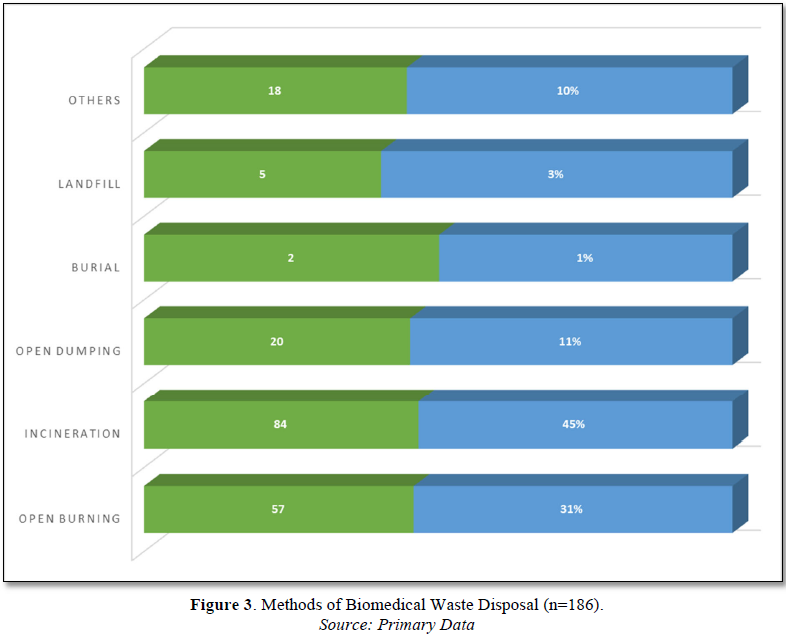
Most 84 (45%) respondent reported that biomedical wastes were disposed off through incineration followed by open burning 57 (31%), open dumping 20 11%), other methods 18 (10%), landfill 5 (3%) and about 2 (1%) responded that wastes were disposed off through burial.
DISCUSSION
Demographic Data
More than half of the respondent 108 (58%) were among the age group of 35 years and above followed by 25-35 years 63 (34%) while 15 (8%) were at the age group of 18-24 years. Majority of the respondent 111 (60%) were male while 75(40%) were female. Most of the respondent 47 (25%) were certified nurses followed by cleaners 26 (14%) while the least respondent were vaccinators, laboratory technologist, Public Health officers and pharmacist representing 1% respectively.
Type of biomedical Waste generated
Majority of the biomedical waste 92 (26%) were general/noninfectious waste, this was followed by sharps 85 (24%) and infectious waste 64 (18%). The least type of waste generated was radioactive waste 3(1%). As stated above, general/infectious waste forms the greatest quantity generated in the hospital. This could be because patients and co-patients generate waste in the process of getting service while healthcare workers generated waste in the process of rendering services. That aside, Al-Sabbah being the only referral hospital for children have many departments including wards. Each generates waste like papers from printing, patient management and filing as most of the records are done manually on hard copy. This led into huge production of general waste in the hospital; Sharps 85 (24%) formed the second most produced waste in Al-Sabbah children hospital could be due to activities rendered in the hospital like immunization and the administration of some injectable drugs; the sharps should always be put in a puncture proof container and must be disposed off with an appropriate method when it is three quarter full; Infectious waste 64 (18%) was the third highly generated waste in the hospital. Such kind of waste contains infectious organism. It, therefore, calls for proper management processes. While the generation of the radioactive waste forms the least 3 (1%), it could be due to unavailability of the service in the hospital during the study period. These research findings were like findings from Mhady [7]. In their study, they found out that general waste was highly generated (100.0%), followed by sharps 140(82.8%), infectious 136(80.5%), and pathological 110(65.1%) respectively. However, according to a study conducted by Mbarki [8], they found out that the general waste produced in hospitals were about 69.5%, pharmaceutical and cytotoxic 10.6%, biological 8.3%, sharps 7.4% and pathological 4.2%. The relationship in the findings could be because all the studies were conducted in hospitals setting thus produced similar findings.
Biomedical waste Disposal methods
Most 84 (45%) respondent reported that biomedical wastes were disposed off through incineration followed by open burning 57 (31%), open dumping 20 (11%), other methods 18 (10%), landfill 5 (3%) and about 2 (1%) responded that wastes were disposed off through burial. Much as incineration was the most method used in disposing off biomedical waste at Al-Sabbah children hospital, having the other disposal methods combine still indicates that there is need to reinforce the incineration method or adopt better ways of managing biomedical waste like the landfill as eventually remaining waste like the ash from incineration would still be taken or carried to landfill. It is also crucial to note that current practice of open burning 57 (31%) and Open dumping 20 (11%) be ended immediately as such practices end up producing dangerous gases that when inhaled can be disastrous to the body. Also, chemicals from decomposition of openly dumped biomedical waste eventually get carried or washed into the nearby streams and major river like the River Nile that the population of Juba is depending on causing short- and long-term health problem to the population. These study findings were in disagreement with a study conducted on assessing the impacts of improper medical waste disposal and residents’ perception of their disposal practices in hadejia metropolis, jigawa state, Nigeria; their findings indicated that Burning 56.7% was mostly used for disposing off biomedical waste followed by burial 23.3% [9]. Not only that, but the current findings also differed from research conducted by Longe [10]. According to them, uncontrolled open burning of non-segregated Health Care Waste (HCW) was prominent in 80% hospitals of Lagos state, Nigeria. Furthermore, the current findings deviated from results of a study conducted by Abanobi & Opara [11] on assessment of medical waste management practices in selected hospitals in Owerri, Nigeria, it shown that Open Dumping 64.3% was mostly used followed by incineration of waste 10%.
CONCLUSION
The research found out that majority of the biomedical waste generated in Al-Sabbah Children Hospital was general/noninfectious waste, Sharps, and infectious waste. The least waste generated was radioactive waste. Besides, this research also established that most of the biomedical wastes were disposed off through incineration followed by open burning, open dumping, and burial as the least method of biomedical waste disposal. Much as incineration was the most method used in disposing off biomedical waste at Al-Sabbah children hospital, having the other disposal methods combine still indicated that there was need to reinforce the incineration method or adopt better ways of managing biomedical waste like the landfill as eventually remaining waste like the ash from incineration would still be taken or carried to landfill.
RECOMMENDATIONS
- The author recommends the use of protected landfill for the disposal of other waste products like the ash that are produced after incineration.
- The Hospital Administration should provide adequate number of color-coded waste collection bins to all departments to ease bio-medical waste collection and segregation.
- The author also recommends for continuous training and mentorship of all health and non-healthcare workers on Infection Prevention and Control (IPC).
- Provision of job aids written both in English and local Arabic to all departments illustrating techniques on bio-medical waste management will add on the current knowledge of staffs at Al-Sabbah hospital.
ACKNOWLEDGEMENT
This work is dedicated to my wife Mrs. Mary Sura, my dear father Mr Lukajo Felix, Mother Mrs. Tamara Muding, my brothers and their family members, my sisters and not forgetting my friends. It is all through your inspiration, guidance and support that made me reach this milestone.
On a special note, I also want to thank my supervisor Prof. Kyriakos Kouveliotis for his immense support in guiding me through the whole research process.
Above all, I also want to give thanks to God Almighty for his protection and guidance through the whole academic period.
- Pasupathi P, Sindhu S, Ponnusha BS (2011) Biomedical waste management for health care industry: A review. Int J Biol Med Res 2(2): 472-486.
- Baveja G, Muralidhar S, Aggarwal P (2000) Hospital waste management-an overview. Hospital Today 5(9): 485-486.
- Da Silva CE, Hoppe AE, Ravanello MM, Mello N (2005) Medical wastes management in the south of Brazil. Waste Manag 25(6): 600-605.
- Alvim-Ferraz MCM, Afonso SAV (2005) Incineration of healthcare wastes: Management of atmospheric emissions through waste segregation. Waste Manag 25(6): 638-648.
- Abdulla F, Qdais HA, Rabi A (2008) Site Investigation on Medical Waste Management Practices in Northern Jordan. Waste Manag 28(2): 450-458.
- Uysal F, Tinmaz E (2004) Medical waste management in Trachea region of Turkey: Suggested remedial action. Waste Manag Res 22(5): 403-407.
- Mhady AIA, Awad MA, Al-Aghah MR, El-Nahhal YZ (2019) Assessment of Medical Waste Management in El Shifa and Al Aqsa Hospitals-Gaza Strip. Health 11(08): 1028-1042.
- Mbarki A, Kabbachi B, Ezaidi A, Benssaou M (2013) Medical Waste Management: A Case Study of the Souss-Massa-Draa Region, Morocco. J Environ Prot 4(9): 914-919.
- Gambo J, Ahmed G, Hadejia HZ, Idris AM, Babura BS, et al. (2018) Assessing the Impacts of Improper Medical Waste Disposal and Residents Perception of their Disposal Practices in Hadejia Metropolis, Jigawa State, Nigeria. Niger Res J Chem Sci 4: 26-37.
- Longe EO (2012) Healthcare waste management status in Lagos State, Nigeria: A case study from selected healthcare facilities in Ikorodu and Lagos metropolis. Waste Manag Res J Int Solid Waste Public Cleansing Assoc 30: 562-571.
- Abanobi OC, Opara KN, Nwakwuo GC, Morakinyo OM (2011) Assessment of medical waste management practice in selected hospitals: A case study of Owerri, Nigeria. J Environ Health Niger 8: 7-12.
QUICK LINKS
- SUBMIT MANUSCRIPT
- RECOMMEND THE JOURNAL
-
SUBSCRIBE FOR ALERTS
RELATED JOURNALS
- Journal of Cell Signaling & Damage-Associated Molecular Patterns
- Dermatology Clinics and Research (ISSN:2380-5609)
- Journal of Immunology Research and Therapy (ISSN:2472-727X)
- Stem Cell Research and Therapeutics (ISSN:2474-4646)
- Journal of Alcoholism Clinical Research
- Journal of Forensic Research and Criminal Investigation (ISSN: 2640-0846)
- Oncology Clinics and Research (ISSN: 2643-055X)




